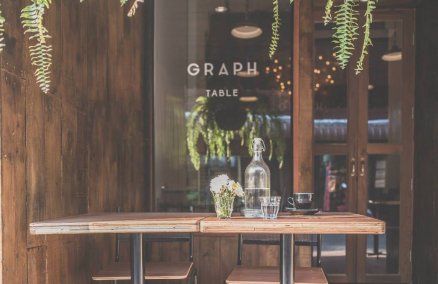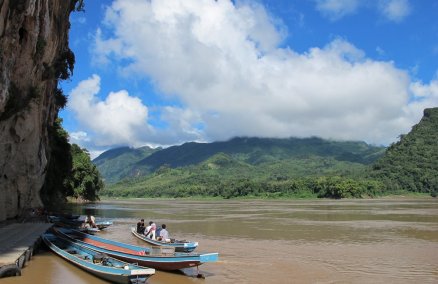The New Year is a time to break out of old habits and make resolutions. To trade your never-used gym membership for a never-to be-used yoga pass. And when it comes to travel, it pays to look to new destinations too. Here are some off-the-beaten-track spots we think are set to be big this year. You just need to get there before everyone else does.
I-S Asks: Where looks set to be hot this year?

“We are seeing newer flight destinations emerge, which include the likes of Sydney, Ho Chi Minh and Xi’an Xianyang.”
Chua Hui Wan, CEO of travel bookers ZUJI

“There is a rising trend for luxurious destinations such as the Maldives, made more affordable by budget airlines.”
Vikram Malhi, general manager for online travel bookers Expedia

“Europe continues to be a big draw, with Paris, London, Barcelona, Rome and Florence dominating travelers’ wish lists.”
Alan Chang, managing director for Airbnb (Northeast Asia)

“We predict a real mix of destinations for Singaporeans in 2014; from the Maldives to Taipei, new low cost airline routes are grabbing the interest of Singapore-based travelers who want to visit somewhere new on holiday.”
Andy Sleigh, general manager of travel comparison site Skyscanner
PARO, BHUTAN
If you’ve climbed Kinabalu and can’t get enough of mountains.

The Himalayan kingdom of Bhutan is characterized by rugged mountains, deep valleys and undisturbed forest, with a rich Buddhist heritage reflected by its cliff-top monasteries and red-robed monks, while the nation advocates the philosophy of Gross National Happiness. Indeed, Joni Herison, Director of Bhutan travel specialist Druk Asia, tells us: “The reason many travelers enjoy Bhutan is the country’s warm, hospitable people.” Despite the hefty tourism fee of USD200/250 [$254/317] per night, accommodation, food and transport is all included, as well as a guide. Start your trip from the culturally rich town of Paro, nestled in a valley in south-west Bhutan.
Discover
Spiceroads, Bhutan Heritage by Bicycle
Starting in Paro, this seven day tour, leads you on a 190km cycle route to mountain monasteries and through forests and valleys, incorporating visits to cultural sites such as Tiger’s Nest temple complex. The tour costs USD2,300 ($2,913), next scheduled for 24 March. www.spiceroads.com/tours/bhutan_heritage_cycle
World Expeditions, Bhutan Dragon Kingdom
If you’d rather explore on foot, this 11-day tour consists of a seven-day trekking and camping journey, high above Paro and Thimphu valleys with views of the Himalayan peaks separating Bhutan and Tibet. You also get to visit the markets, monasteries and fortress-like dzongs of Paro and Thimphu. The next tour is from April 5 and costs USD$4,190 ($5,308). www.worldexpeditions.com



Stay
Uma by Como, Paro
At this luxury resort in Paro Valley, villas are each situated in their own glade, with valley, forest and mountain views, combining artisanship with contemporary luxe. The property features Bhutanese hot stone bathhouses, an indoor pool with alfresco sundeck, steam rooms, and a yoga studio with valley views. It serves as an ideal base for camping, hiking and cycling. The five-night Himalayan Explorer package starts from USD5,800 ($7,297) per person. PO Box 222, Paro, Bhutan, 97 5827-1597, www.comohotels.com/umaparo
Getting there
Fly from Singapore to Paro with DrukAsia (www.drukasia.com) for around $1,250.
When to Go
Bhutan can be visited all year round. It has a dry spring from March to mid-April, a warm early summer from mid-April to June, the monsoon season from June to late September, a cool autumn from September to November, and a cold winter, with snow, from November to March.
RAJA AMPAT, INDONESIA
If you’re done with diving in Thailand.

Travel magazines hype Raja Ampat as “the world’s last paradise,” and it’s something of a whispered secret among dive aficionados. The string of mountainous and rainforest covered islands are fringed by pristine white sand, merging into azure waters, with coral reef lying below the surface. The archipelago has one of the world’s richest marine habitats, while forests are teeming with wildlife. This natural phenomenon of land and sea biodiversity is what brings people here as they explore by boat and underwater and trek through rainforest to seek out the islands’ caves and waterfalls.
Discover
Premier Liveaboard Diving
Choose from packages of nine to 13 nights, with prices dependent on the type of boat (from $265 per night). An all-inclusive trip on Damai, which acommodates 8-10 people, costs $550 per night, inclusive of spa treatments, unlimited diving, and park fees, as well as food and drink. www.rajaampat.liveaboarddiving.net
Lightfoot Travel Liveaboard Cruises
For luxury sailing around the islands, with the expertise of an expedition leader, crew and divemaster, Lightfoot Travel has a range of exclusive yachts and phinisi ships that can be chartered for liveaboard trips. Charter of Tiger Blue (pictured on cover) for up to 10 guests, including all food, tours and watersports costs USD4,400 ($5,595) per night. www.lightfoottravel.com



Stay
Misool Eco Resort
Striking a balance between luxury and conservation, Misool is located in remote southern Raja Ampat, surrounded by uninhabited islands, inside a 1,220 sq. km. No-Take zone and 46,000 sq. km. Shark and Manta Sanctuary. The resort’s villas offer seclusion, alongside white sand, and coral-rich water. The beachside restaurant serves up fresh organic fare, with a terrace for sunset cocktails, while the dive center overlooks the water, with its own jetty for dive boats. Packages of seven nights start from €2,090 ($3,557). Batbitim Island, 629 5132-2613, www.misoolecoresort.com
Getting there
Fly from Singapore to Sorong with Garuda Indonesia (www.garuda-indonesia.com) for around $984.
When to Go
The best time to go is during the dry season, which is the peak diving season, running from October to April.
CHENGDU, CHINA
If you’ve had your fill of city breaks in Shanghai and Beijing.

As one of China’s most populous cities Chengdu isn’t exactly a hidden gem. Still, it’s often overlooked for its bigger siblings Shanghai and Beijing. Offering a juxtaposition of old world charm and modern metropolis, the city has more green space than its counterparts, and is celebrated for its rich cultural heritage, exceptionally spicy food, emerging contemporary arts scene and—the big draw—the chance to snuggle up to pandas. Kelly Gillease of tour specialist Viator tells us: “The vivid colors help paint the picture of amazing experiences here: black and white of giant pandas; red of the Sichuan chili; blue of the hot spring; green of the tea leaves; silver of Qingcheng Mountain; and gold of the Leshan Buddha.”
Discover
Viator full day tour: Panda Breeding Center and Sanxingdui Museum
This tour combines the opportunity to see the pandas up close at Chengdu Panda Breeding and Research Center with an insight into Chinese culture at the Bronze Age archaeological site, Sanxingdui Museum. The tour costs USD117 ($148) per person. www.viator.com
China Exploration Three-Day Epicure Tour of Sichuan Food
For a real taste of Chengdu’s spicy cuisine, take part in this three-day introduction to local specialties like Shujiuxiang hot pot, Xiba bean curd and roasted rabbit’s head, while visiting food markets, temples, the famed Panda Garden and Leshan Giant Buddha. The tour costs USD273 ($347) not including accommodation. www.chinaexploration.com



Stay
Shangri la Chengdu
Located in central and historic Swell Fun—the world’s oldest wine lane, featuring wineries from past dynasties—this hotel overlooks Jinjiang River from its location next to Hejiang Pavilion, reflecting Chengdu’s fusion of colorful history with modern style. The property features four restaurants, a bar with live music, and a spa offering Chinese wellbeing treatments, as well as a pool, sauna and tennis court. Room rates start at CNY1,129 ($236). 9 Binjiang East Road, Jinjiang, Chengdu, Sichuan, 86 28 8888-9999, www.shangri-la.com/chengdu/shangrila
Getting There
Flights with Cathay Pacific (www.cathaypacific.com) cost around $500, while flights with China Southern (www.csair.com) cost around $540; most of which travel via Guangzhou.
When to Go
Spring is warm, followed by a short hot and humid summer, cool and rainy autumn, then a cold and foggy winter. The summer months can be stiflingly hot.
SHIKOKU, JAPAN
If you’re obsessed with Japan but maxed out on Tokyo.

As popular as Japan is in Singapore, not many make it to the smallest of the country’s four major islands, Shikoku. Between the mountains and lush green valleys lie waterfalls, vine bridges and temples, including the 88 Sacred Temples of Shikoku, a 1,400km Buddhist pilgrimage still undertaken today. In fact, Shigeo Konishi of Tourism Shikoku tells us: “The reason to visit this year has to be the 1200th anniversary of the creation of the pilgrimage in Shikoku.” The island is also known for its hand-made ‘sanuki udon’ noodles, locally grown fruit and fresh seafood, while also retaining many of its traditions.
Discover
Japan Roads – Shikoku Tour
This tour takes you around historic Himeji and Kurashiki, and cultural Takamatsu, before travelling to see the natural beauty and soak in the hot springs of the Iya Valley and Takamatsu. This seven-day tour costs USD2,210 ($2,780) per person. www.japanroads.com
Awa Odori Festival
During Obon, the festival of the dead when spirits are welcomed back to their ancestral homes, Tokushima is taken over by Japan’s biggest dance festival Awa Odori (dance of the fools). Mid-August each year, musicians and dancers parade through the streets, encouraging festival revellers to join the fun. Visitors need to book ahead for hotels. For more info head to www.jnto.go.jp/eng/location/spot/ festival/awaodori



Stay
Hotel Kazurabashi
In its prime location in Iya Valley, this hotel is close to waterfalls and the island’s famous vine bridge. The traditional Japanese hotel incorporates natural open-air hot spring baths, accessed by cable-car, and is noted for its exceptional cuisine. Time can be spent hiking, white water rafting and relaxing in the famed hot springs. Room rates start from JPY16,000 ($193), dependent on season. Miyoshi, Tokushima Nishiiyayama 33-1, 08 8387-2171, www.kazurabashi.co.jp
Getting There
Japan Airlines (www.jal.com) and ANA (www.ana.co.jp) have flights from Singapore to Tokushima for around $935.
When to Go
Shikoku has snow in winter and high temperatures in summer. The rainy season is from early June to mid-July. Aside from the festival period, autumn and spring are the most popular times to visit.
BAGAN, MYANMAR
If you liked exploring the ancient ruins of Angkor Wat.

The number of tourists finding their way to Myanmar has been rising steadily, with more convenient travel options and luxurious places to stay, but the country still manages to retains its unique identity. Robert Carmack and Morrison Polkinghorne of Globetrotting Gourmet tell us: “Myanmar is Asia’s last frontier. Here, you experience a lifestyle of yesteryear, but most of all, Myanmar is a top destination because of its people—surely the friendliest and most gentle souls in the world.” Bagan is one of the country’s must-see spots—a vast landscape dotted with over 2000 ruins of pagodas, temples and monasteries. Explore by bicycle, stopping to climb the worn stone steps of the ancient temples.
Discover
Globetrotting Gourmet – Burma Up Country Tour
From Yangon you’ll journey to cultural hot spots like Inle Lake and Mount Popa in addition to Bagan itself, sampling regional cuisine while exploring villages, temples and monasteries, watching cooking demonstrations and seeking out traditional handicrafts. The tour takes place April 13- 23 for USD 5,795 ($7,264). www.globetrottinggourmet.com
Balloons Over Bagan
The most memorable way to see Bagan’s ancient ruins has to be by hot air balloon. In the early morning light with mist rising over the temple ruins, the balloons drift over the iconic landscape, before landing where you’re met with fruit, pastries and Champagne. Until March 31, flights cost USD 320 ($401) per person. www.easternsafaris.com



Stay
Aureum Palace
This luxury resort and spa is located among Bagan’s ancient temples, making it an ideal base for easy exploration. Villas are set inside the property’s landscaped tropical gardens, some with private pools, others that replicate the temples themselves; all sleekly designed with distinct Burmese features. There’s also an art gallery, pool and spa, for when you’re not out exploring. Rooms are from USD299 ($379). Min Nanthu, Nyaung U, Mandalay, 9 5616- 0046, www.aureumpalacehotel.com
Getting there
Return flights to Yangon cost $244 with Tigerair (www.tigerair.com) or $270 with Myanmar Airways International (www. maiair.com). Yangon to Nyaung-U (near Bagan) flights can be booked with Air Mandalay (www.airmandalay.com), cost dependent on the season. Alternatively, take an overnight train—more information can be found at the train travel site Seat 61 (www.seat61.com).
When to go
November to February is dry, then the peak season of March to May, is very hot, after which June to October becomes wet.
QUANG BINH, VIETNAM
As impressive as Halong Bay, minus the crowds.

Experience the world’s largest cave systems tunnelling through ancient mountains by venturing into the UNESCO World Heritage Site, Phong Nha Ke-Bang National Park of Quang Binh Province. Son Doong, the world’s largest cave, was only recently discovered and for the first time is open to tourists. Luke Ford, Director of Oxalis Adventure Tours, tells us: “Son Doong is quite possibly the most beautiful untouched paradise on Earth. It is spectacular.” Just 220 tourists permits were granted to Oxalis, the only operator to run tours here. This first phase is booked out, but you can still visit the province’s breath-taking cave formations of Hang En and Tu Lan, both reached by trekking across pristine jungle and river valleys.
Discover
Oxalis, Tu Lan Cave System
From Phong Nha, Oxalis offer one to four day tours. The Tu Lan Three-Day Exploration tour involves trekking across 10km of jungle and limestone path, before exploring the caves themselves to witness their spectacular formations, underground rivers and waterfalls. By night you’ll share BBQ dinners and camp under the stars. The tour costs USD325 ($410) per person, including all safety and camping gear. www.oxalis.com.vn
Oxalis, Hang En Ultimate Two-Day Adventure
After leaving Phong Nha, the guides lead the way through jungle, across rivers and streams, and to remote villages, before arriving at the majestic Hang En Cave. A highlight of the tour is spending the night camping in the cave. The tour costs USD275 ($347), including equipment, departing on Saturdays.



Stay
Before starting out on your adventure or as a reward La Residence Hue Hotel & Spa is a luxurious French Colonial design hotel on the banks of The Perfume River. This art deco property features a saltwater pool, spa and tennis courts, plus guests can book tours and cooking classes, as well as culinary experiences like a picnic lunch among the pine trees of Thien An Hill. The hotel houses the opulent Le Gouverneur bar and La Parfum fine dining restaurant. Room only rates start from USD176 ($222). 5 Le Loi, Vinh Ninh, Hue, Thia Thien, 845 4383-7475, www.la-residence-hue.com
Getting There
Flights from Singapore to Hué are available for around $375 with Vietnam Airlines (www.vietnamairlines.com). From Hué you can take a bus or train to Dong Hoi, then another bus to Phong Nha.
When to Go
March to November is the ideal time to visit when the temperature is most comfortable. The heat rises significantly from May to September, after which October to February is the rainy season. October to November has very heavy rain, so is best avoided.











































